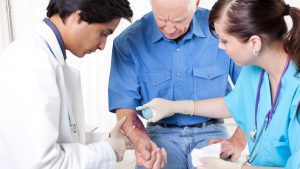
Colzyx’s innovative wound care technology restricts microbial growth whilst simultaneously promoting wound healing.
Antimicrobial resistance (AMR) is a global public health concern, resulting in 33,000 deaths in the EU every year. It is caused by the overuse of antibiotics and antiseptics. For clinicians, diagnosing wound infections can be very challenging. By overprescribing antibiotics, AMR in wounds is becoming more and more serious.
A new solution to wound care needs to incorporate treating the site of infection, as well as promoting wound healing to provide protection. Colzyx has been developing this type of approach to wound care, with the potential to change the future of chronic wound management. Health Europa spoke to Eskil Söderlind, CEO, and Matthias Mörgelin, CTO of Colzyx, about the burden of chronic wounds and how their company seeks to mitigate this through their innovative wound care technology.
What are the key challenges currently facing the healthcare sector in managing chronic wounds and what kind of impact has the COVID-19 pandemic had on that?
MM: The key challenge concerning the pandemic is the growing backlog in care as the healthcare industry endeavours to mitigate the COVID-19 crisis and support infected patients. In terms of wound care, the main issue is managing those wounds that become chronic and infected.
Currently, there are no products on the market which simultaneously restrict bacterial growth in the wound and stimulate wound healing in order to provide protection. This is a concern because there is a growing population of antibiotic resistant microbes, which is increasing on a global level. Our product can combat multidrug resistant bacteria and will combat multidrug resistance more widely as a result.
ES: The development of multidrug resistant bacteria is a very severe threat to human health. As a global community we must tackle one thing at a time, and people are currently focusing on COVID-19. But when that is eventually defeated, we still have the emerging problem of multidrug resistant bacteria.
Our product can contribute to combatting that threat because, as Matthias says, our product will accelerate wound healing, while simultaneously killing multidrug resistant bacteria. That combination is unique.
MM: There is one example of a bacterium called Staphylococcus aureus (MRSA) which is already multidrug resistant and a current threat for chronic wound patients.
Would you say there are certain societal groups or demographics who are more susceptible to developing difficult to treat wounds?
MM: Elderly people, immunocompromised people, and COVID-19 patients may be more susceptible to developing chronic wounds but these are not a major driving force for wound chronicity.
ES: We also have a diabetic pandemic situation. Globally, the number of people being diagnosed with diabetes is increasing. This is associated with chronic or diabetic foot ulcers, for example. Obesity is also a factor.
As Matthias said, the population is ageing, and wounds that are difficult to heal are associated with age. That is the situation that we are in. It is important to come back to the multidrug resistant bacteria perspective again because that is a gender and age unrelated situation. However, if you are young and very healthy, you can still catch an infection.
MM: AMR is advancing in such a way that a harmless intestinal infection can now be deadly, such as when the gut is infected with multidrug resistant Enterococcus. We are slowly moving towards the same situation in the chronic wound field.
Can you tell me about the main benefits of your WOUNDCOM technology compared to conventional wound dressings that we have on the market today?
MM: Conventional wound dressings can kill bacteria, as some wound dressings contain antibiotics or collagen. Our product combines bacterial killing and wound healing promotion and is the only known product to do this at the moment. This is because we discovered the collagen VI, which is a connective tissue component, and is part of the name Colzyx.
Collagen VI is an innate component of connective tissue and whenever we have a wound, collagen VI will actively promote wound healing and prevent the wound becoming infected. We are developing a product that mimics these biological processes, which no other product can do.

What stage is your technology currently at and what are your plans for 2022?
ES: We are aiming to start the clinical trial at the end of 2022. Things are running well; we are making all the necessary preparations to be allowed to start a clinical trial.
MM: Our wound care technology can potentially, in the future, also be applied to acute wounds, like surgical site infections (SSI) and other related problems, such as trauma wounds.
Looking ahead, how do you hope that Colzyx is going to further evolve? Do you have any other ideas or plans in the pipeline that you would like to share with our readers?
ES: We have some key intellectual property assets here. These include molecules that we and co-inventors have identified and obtained a patent for in the US and in China, and we are expecting to get a patent in Europe as well. These are molecules that are highly antibacterial and promote wound healing. These key assets can be used in a variety of applications.
What we are aiming at for the next project, that is connected to wound healing, is looking into developing new types of antibiotics. This would use some of the key chemical components that have been identified for the wound healing project.
MM: The technology will benefit from our innate bodily properties. In regard to orthopaedic implants, for example, unnatural products are used, such as titanium, which the body recognises as foreign. The body will encapsulate them, which is a prolonged reaction to finally reject them.
If we coat these materials with our substances, the body most likely will recognise these objects as non-foreign. This will mean that they grow into the body and into the tissue and will be incorporated in a much better way. That is a potential application.
ES: To summarise what Matthias said, we have our wound care project, we have the antibiotics project, and we also have a project in coating implants with these molecules to promote healing and prevent infections. There are many different ideas and ways you can utilise our core findings.
Eskil Söderlind
CEO
Matthias Mörgelin
CTO
Colzyx
www.colzyx.com
https://www.linkedin.com/company/colzyxab/
This article is from issue 20 of Health Europa Quarterly. Click here to get your free subscription today.
























